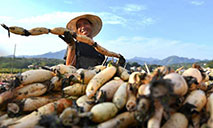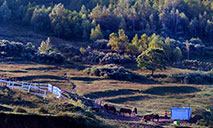African serval starts new life in Beijing amid stronger wildlife protections
BEIJING, Oct. 9 (Xinhua) -- A leopard-like serval, which traditionally inhabits the grasslands of Africa, is being kept at an aid station of Beijing Wildlife Park after being rescued in the wild of Beijing's suburban Fangshan District in late August.
Compared with other felines, the yellow serval with black spots looks much slenderer with longer legs, a shorter tail, and large ears. It now enjoys a comfortable life at the station.
The serval was initially found in Fangshan by local villagers and then rescued jointly by a nearby animal protection group and staff from the Beijing Municipal Forestry and Parks Bureau.
"The serval had a strong stress response when being rescued. Thanks to the timely and professional treatment and care, it started to eat three days after being rescued," said Hu Yan, deputy director of the Beijing Wildlife Rescue Center.
Hu said the serval, as an alien species in China, would endanger other local felines if it were to settle down and reproduce in Beijing. "So we cannot release the serval into the wild. It cannot be sent back to Africa either according to international conventions. Therefore, the serval will be kept for scientific education and display."
As soon as the serval was found, the bureau checked all the wildlife reproduction and research centers in Beijing, but no serval escape was reported.
"The serval may have been privately raised and then abandoned or released. It is an alien species indeed, but it should be protected under second-class national protection according to international conventions and related regulations in China," said Zhang Zhiming, an official with the forestry and parks bureau.
"Beijing has continuously strengthened the protection and rescue of wildlife," Zhang said. By Sept. 15, a total of 227 species and 2,384 wild animals have been rescued in Beijing this year, according to statistics released by the bureau.
China's biodiversity conservation efforts pursue harmony between humanity and nature, aiming to create a virtuous circle for all-around development and prolonged prosperity for all. To help ensure the success of the Beautiful China initiative, China is improving its measures for biodiversity conservation and creating new frameworks, according to the white paper titled "Biodiversity Conservation in China" released Friday by the State Council Information Office.
According to the bureau, the number of wild animals and plants in Beijing has continued to grow in recent years, which hit 2,669 species in 2020, including 81 key protected wildlife species such as brown eared pheasant, black stork and elk. In addition, an increasing number of endangered migratory birds also choose to stay in Beijing.
As the autumn and winter migration period is approaching, field inspections will be further enhanced in breeding grounds, migration stops and other areas where migratory animals gather to provide a favorable living environment for wildlife, Zhang added.
Beijing has established 79 natural reserves over the past four decades, with a total area of 368,000 hectares, accounting for 22 percent of the city area. A biodiversity protection network based on natural reserves and supported by natural parks is taking shape, Zhang said.
Photos
Related Stories
- Beijing parks welcome over 2 mln visitors during holiday
- Highlights of Experience Beijing Speed Skating China Open
- Roads for testing self-driving vehicles in Beijing stretch over 1,000 km
- Newly-opened Beijing Winter Olympic park attracts tourists during National Day Holiday
- Beijing-style bubble tea: time-honored food brand infuses classic beverage with a new retro taste
Copyright © 2021 People's Daily Online. All Rights Reserved.










